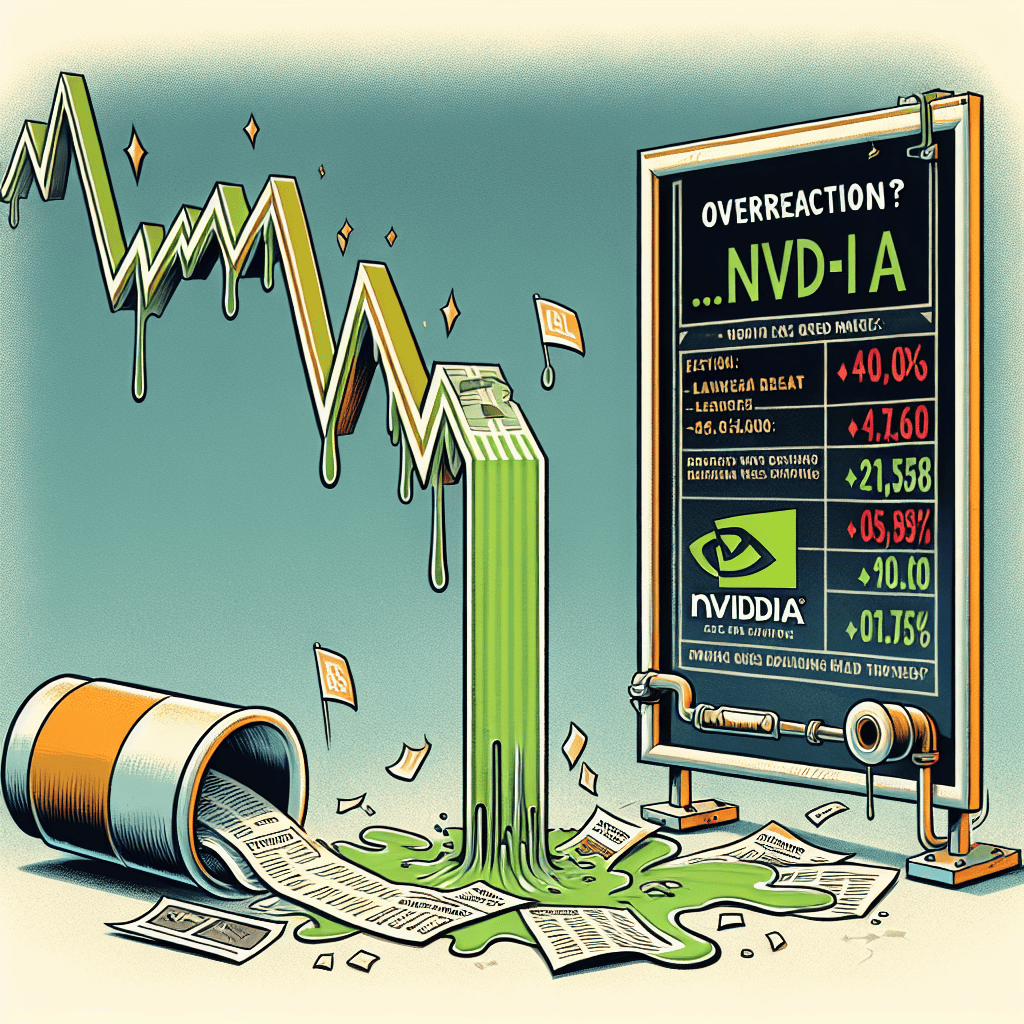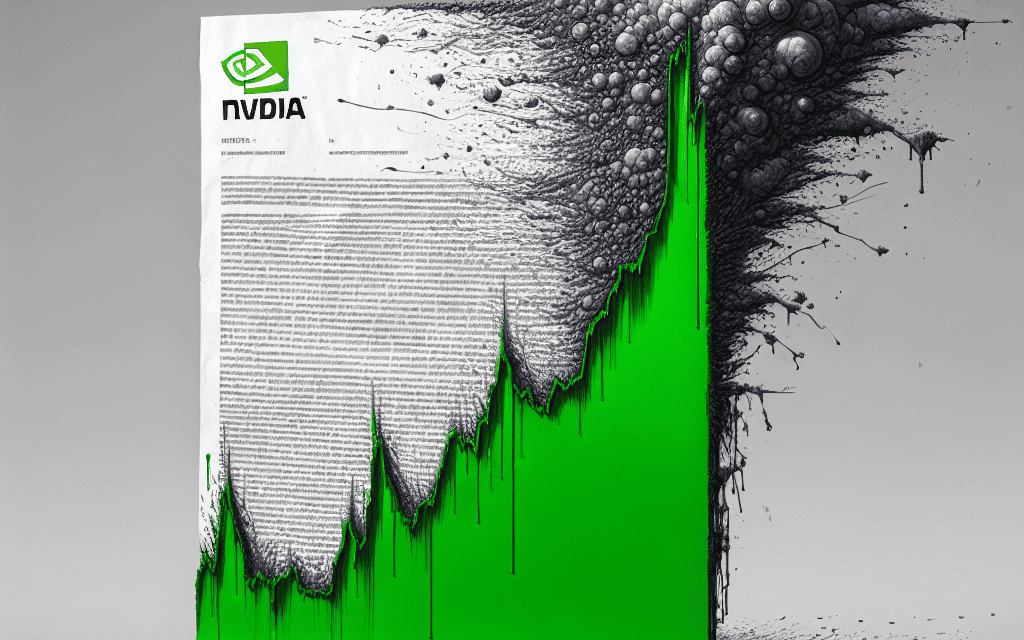“Nvidia’s Dip: A Temporary Blip Amid ASML’s Earnings Stir.”
Introduction
Nvidia’s stock experienced a notable decline following the premature release of ASML’s earnings report, which sent ripples through the semiconductor industry. The unexpected leak led to heightened market volatility, as investors reacted swiftly to the news. However, the drop in Nvidia’s stock price appears to be an overreaction, driven more by short-term market sentiment than by any fundamental issues within the company itself. Nvidia remains a leader in the graphics processing unit (GPU) market, with strong growth prospects fueled by advancements in artificial intelligence, gaming, and data center technologies. The company’s robust financial health and strategic positioning suggest that the market’s response may not accurately reflect Nvidia’s long-term potential, making the dip a potential opportunity for investors.
Impact Of ASML Earnings Leak On Nvidia Stock
The recent decline in Nvidia’s stock following the premature release of ASML’s earnings report has sparked considerable discussion among investors and analysts alike. While the initial reaction to the leak was a noticeable drop in Nvidia’s stock price, a closer examination suggests that this response may be an overreaction. To understand the situation fully, it is essential to explore the relationship between ASML and Nvidia, the nature of the leak, and the broader market context.
ASML, a leading supplier of photolithography equipment used in semiconductor manufacturing, plays a crucial role in the supply chain for companies like Nvidia. The performance of ASML can often serve as a bellwether for the semiconductor industry as a whole. Therefore, any unexpected news regarding ASML’s financial health can have ripple effects on companies that rely on its technology. In this instance, the early release of ASML’s earnings report, which contained results that fell short of market expectations, led to a knee-jerk reaction among investors, resulting in a sell-off of Nvidia shares.
However, it is important to consider that Nvidia’s business model and market position are not directly tied to ASML’s quarterly performance. While ASML’s equipment is integral to the production of Nvidia’s graphics processing units (GPUs), Nvidia’s success is driven by a multitude of factors, including its innovation in AI technology, its expanding data center business, and its leadership in the gaming industry. These elements contribute to Nvidia’s robust growth trajectory, which remains largely unaffected by short-term fluctuations in ASML’s earnings.
Moreover, the semiconductor industry is characterized by cyclical trends, and temporary setbacks in one quarter do not necessarily indicate long-term challenges. Nvidia has consistently demonstrated resilience and adaptability in navigating these cycles, leveraging its strong research and development capabilities to maintain a competitive edge. Consequently, the market’s swift reaction to ASML’s earnings leak may not accurately reflect Nvidia’s underlying strengths and future prospects.
In addition to Nvidia’s inherent strengths, the broader market context should also be taken into account. The technology sector has experienced heightened volatility in recent months, influenced by macroeconomic factors such as interest rate changes, geopolitical tensions, and supply chain disruptions. These external pressures can exacerbate market reactions to individual company news, leading to exaggerated stock price movements. Therefore, the decline in Nvidia’s stock following the ASML earnings leak should be viewed within this larger framework of market dynamics.
Furthermore, investor sentiment can often be swayed by short-term news events, leading to decisions that may not align with a company’s long-term value. In the case of Nvidia, the company’s strategic initiatives, such as its advancements in AI and machine learning, position it well for sustained growth in the coming years. As such, the recent dip in stock price may present a buying opportunity for investors who recognize Nvidia’s potential and are willing to look beyond the immediate market noise.
In conclusion, while the early release of ASML’s earnings report prompted a swift decline in Nvidia’s stock, this reaction appears to be an overreaction when considering Nvidia’s strong fundamentals and strategic positioning. By examining the broader context and focusing on Nvidia’s long-term growth drivers, investors can gain a more balanced perspective on the company’s prospects, potentially viewing the recent stock drop as a temporary blip rather than a cause for concern.
Analyzing The Overreaction To Nvidia’s Stock Drop
Nvidia’s stock recently experienced a notable decline following an unexpected early leak of ASML’s earnings report. This event has sparked considerable discussion among investors and analysts, with many questioning whether the market’s reaction was justified. To understand the situation fully, it is essential to examine the factors contributing to the stock’s drop and assess whether the response was indeed an overreaction.
Initially, it is important to recognize the interconnected nature of the semiconductor industry. Companies like Nvidia and ASML are integral components of a complex supply chain, and developments in one company can have ripple effects throughout the sector. ASML, a leading supplier of photolithography equipment used in semiconductor manufacturing, plays a crucial role in the production capabilities of companies like Nvidia. Therefore, any news regarding ASML’s financial performance can understandably influence investor sentiment towards Nvidia.
The early leak of ASML’s earnings report revealed results that were below market expectations, leading to concerns about potential slowdowns in the semiconductor industry. Investors, already on edge due to broader economic uncertainties, reacted swiftly, resulting in a sell-off of Nvidia’s stock. However, it is crucial to consider whether this reaction was proportionate to the actual implications of ASML’s earnings.
One must take into account Nvidia’s strong market position and its diverse product portfolio. Nvidia has consistently demonstrated its ability to innovate and adapt to changing market conditions, maintaining a leadership position in areas such as graphics processing units (GPUs) and artificial intelligence (AI). The company’s robust financial health and strategic investments in emerging technologies provide a solid foundation for future growth. Consequently, a temporary dip in stock price, triggered by external factors, may not accurately reflect Nvidia’s long-term prospects.
Moreover, the semiconductor industry is characterized by cyclical fluctuations, with periods of high demand followed by temporary slowdowns. While ASML’s earnings report may suggest a short-term deceleration, it does not necessarily indicate a prolonged downturn. Nvidia’s continued investment in research and development, coupled with its strategic partnerships, positions the company to capitalize on future opportunities as the industry rebounds.
Additionally, it is essential to consider the broader market context. The stock market is often influenced by a myriad of factors, including macroeconomic trends, geopolitical developments, and investor sentiment. In this case, the reaction to ASML’s earnings leak may have been exacerbated by existing market volatility and uncertainty. Investors, wary of potential risks, may have overreacted to the news, leading to a more pronounced decline in Nvidia’s stock price than warranted.
In conclusion, while the early leak of ASML’s earnings report undoubtedly impacted Nvidia’s stock, it is crucial to assess the situation with a balanced perspective. Nvidia’s strong market position, innovative capabilities, and strategic investments suggest that the company’s long-term prospects remain promising. The stock’s decline, driven by external factors and market sentiment, may not accurately reflect Nvidia’s intrinsic value. As such, the drop in Nvidia’s stock price appears to be an overreaction, highlighting the importance of considering the broader context and long-term fundamentals when evaluating investment decisions.
Nvidia’s Market Position Amidst ASML Earnings News
Nvidia, a leading player in the semiconductor industry, recently experienced a decline in its stock value following an unexpected early leak of ASML’s earnings report. This development has sparked discussions among investors and analysts, with many questioning whether the drop in Nvidia’s stock is justified. To understand the situation, it is essential to examine Nvidia’s market position and the broader context of the semiconductor industry.
ASML, a key supplier of photolithography equipment used in semiconductor manufacturing, plays a crucial role in the supply chain of companies like Nvidia. The early leak of ASML’s earnings report revealed results that were below market expectations, leading to concerns about potential ripple effects across the semiconductor sector. Consequently, Nvidia’s stock experienced a decline as investors reacted to the news. However, it is important to consider whether this reaction accurately reflects Nvidia’s current market position and future prospects.
Nvidia has established itself as a dominant force in the semiconductor industry, particularly in the fields of graphics processing units (GPUs) and artificial intelligence (AI). The company’s innovative products and strategic partnerships have enabled it to maintain a competitive edge, even amidst challenges such as supply chain disruptions and fluctuating demand. Moreover, Nvidia’s recent ventures into data centers and autonomous vehicles have further diversified its portfolio, positioning it for sustained growth in emerging markets.
In light of these factors, the drop in Nvidia’s stock following ASML’s earnings leak appears to be an overreaction. While ASML’s performance is undoubtedly significant, it is crucial to recognize that Nvidia’s business model and growth trajectory are not solely dependent on a single supplier. The semiconductor industry is characterized by its complexity and interdependence, with numerous players contributing to the production and distribution of components. Therefore, a temporary setback for one company does not necessarily translate into long-term challenges for another.
Furthermore, Nvidia’s robust financial health and strategic initiatives underscore its resilience in the face of market fluctuations. The company has consistently demonstrated its ability to adapt to changing conditions, leveraging its research and development capabilities to introduce cutting-edge technologies. This adaptability is a testament to Nvidia’s strong leadership and commitment to innovation, which are critical factors in maintaining its competitive advantage.
Additionally, the broader trends in the technology sector suggest a positive outlook for Nvidia. The increasing demand for AI-driven solutions, coupled with the growing adoption of cloud computing and edge technologies, presents significant opportunities for Nvidia to expand its market share. As industries continue to embrace digital transformation, the need for advanced computing power and efficient data processing will only intensify, further bolstering Nvidia’s position in the market.
In conclusion, while the early leak of ASML’s earnings report has undoubtedly impacted Nvidia’s stock in the short term, it is essential to consider the broader context and Nvidia’s inherent strengths. The company’s strategic initiatives, diversified portfolio, and commitment to innovation position it well for future growth, despite temporary market fluctuations. Therefore, the recent drop in Nvidia’s stock should be viewed as an overreaction, rather than a reflection of any fundamental weaknesses in the company’s market position. Investors would do well to focus on Nvidia’s long-term potential, rather than being swayed by short-term market volatility.
Investor Sentiment And Nvidia’s Stock Volatility

Investor sentiment plays a crucial role in the stock market, often driving volatility based on news, rumors, and market perceptions. Recently, Nvidia’s stock experienced a notable decline following an unexpected early leak of ASML’s earnings report. This incident highlights the sensitivity of Nvidia’s stock to external factors, even when they may not directly impact the company’s core business. Understanding the dynamics of investor sentiment and its influence on stock volatility is essential for making informed investment decisions.
The early leak of ASML’s earnings report created a ripple effect across the semiconductor industry, with Nvidia being one of the companies affected. ASML, a key supplier of photolithography equipment used in semiconductor manufacturing, reported results that fell short of market expectations. This news led to concerns about the broader semiconductor supply chain, causing investors to reassess their positions in related stocks, including Nvidia. However, it is important to recognize that Nvidia’s business model and market position differ significantly from ASML’s, suggesting that the market’s reaction may have been disproportionate.
Nvidia, a leader in graphics processing units (GPUs) and artificial intelligence (AI) technology, has a robust product portfolio and a strong foothold in several high-growth markets. The company’s innovations in AI, gaming, and data centers have positioned it as a key player in the tech industry. While ASML’s earnings may provide some insight into the semiconductor sector’s health, Nvidia’s performance is driven by its unique capabilities and strategic initiatives. Therefore, the decline in Nvidia’s stock following ASML’s earnings leak appears to be an overreaction, as the two companies operate in different segments of the semiconductor industry.
Moreover, Nvidia’s recent financial performance has been impressive, with the company consistently delivering strong revenue growth and profitability. Its strategic investments in AI and machine learning have opened new avenues for expansion, further solidifying its competitive advantage. As a result, Nvidia’s long-term growth prospects remain promising, despite short-term market fluctuations. Investors should consider these factors when evaluating the impact of external events on Nvidia’s stock price.
In addition to Nvidia’s solid fundamentals, the broader market context should also be taken into account. The semiconductor industry is currently experiencing a period of rapid transformation, driven by technological advancements and increasing demand for digital solutions. While supply chain disruptions and geopolitical tensions have introduced some uncertainty, the long-term outlook for the industry remains positive. Nvidia, with its innovative products and strategic vision, is well-positioned to capitalize on these trends, making the recent stock drop seem more like a temporary setback rather than a reflection of underlying issues.
Furthermore, it is essential to recognize that stock market volatility is a natural part of investing. Short-term price movements are often influenced by a myriad of factors, including investor sentiment, macroeconomic conditions, and market speculation. While these fluctuations can be unsettling, they also present opportunities for investors to reassess their strategies and potentially capitalize on market inefficiencies. In the case of Nvidia, the recent decline may offer a buying opportunity for those who believe in the company’s long-term potential.
In conclusion, while the early leak of ASML’s earnings report triggered a decline in Nvidia’s stock, the reaction appears to be an overreaction when considering Nvidia’s strong fundamentals and growth prospects. Investors should remain focused on the company’s strategic initiatives and market position, rather than being swayed by short-term market volatility. By maintaining a long-term perspective, investors can better navigate the complexities of the stock market and make informed decisions that align with their investment goals.
Long-Term Prospects For Nvidia Despite Short-Term Fluctuations
Nvidia’s stock recently experienced a notable decline following the premature release of ASML’s earnings report, which sent ripples through the semiconductor industry. However, this drop in Nvidia’s stock price may be an overreaction when considering the company’s long-term prospects. While short-term market fluctuations can be unsettling for investors, it is crucial to examine the broader context and underlying factors that continue to support Nvidia’s growth trajectory.
To begin with, Nvidia has established itself as a leader in the semiconductor industry, particularly in the realm of graphics processing units (GPUs). The company’s innovative products have become integral to a wide range of applications, from gaming and data centers to artificial intelligence and autonomous vehicles. This diversification not only provides Nvidia with multiple revenue streams but also positions it to capitalize on emerging technological trends. As industries increasingly rely on advanced computing capabilities, Nvidia’s expertise in GPU technology places it at the forefront of this evolution.
Moreover, Nvidia’s strategic acquisitions and partnerships further bolster its long-term prospects. The company’s acquisition of Mellanox Technologies, for instance, has enhanced its data center offerings, allowing it to deliver more comprehensive solutions to its clients. Additionally, Nvidia’s collaboration with major players in the automotive industry underscores its commitment to advancing autonomous driving technologies. These strategic moves not only expand Nvidia’s market reach but also reinforce its position as a key player in the semiconductor landscape.
Furthermore, the demand for Nvidia’s products is expected to remain robust in the coming years. The gaming industry, a significant driver of Nvidia’s revenue, continues to grow at a rapid pace. With the advent of cloud gaming and the increasing popularity of esports, Nvidia is well-positioned to benefit from these trends. Simultaneously, the rise of artificial intelligence and machine learning applications across various sectors is likely to sustain demand for Nvidia’s high-performance GPUs. As businesses and researchers seek to harness the power of AI, Nvidia’s products are poised to play a pivotal role in enabling these advancements.
In addition to its strong market position and product offerings, Nvidia’s financial health provides a solid foundation for future growth. The company has consistently demonstrated strong revenue growth and profitability, which is indicative of its ability to navigate market challenges effectively. Nvidia’s robust balance sheet and cash flow generation capacity enable it to invest in research and development, ensuring that it remains at the cutting edge of technological innovation.
While the recent decline in Nvidia’s stock price may have been triggered by external factors such as ASML’s earnings leak, it is essential to recognize that short-term market reactions do not necessarily reflect a company’s intrinsic value. Investors should consider Nvidia’s long-term growth potential, driven by its leadership in GPU technology, strategic initiatives, and strong financial performance. As the semiconductor industry continues to evolve, Nvidia is well-equipped to adapt and thrive, making the recent stock drop appear as an overreaction in the grand scheme of things.
In conclusion, while Nvidia’s stock may experience short-term fluctuations due to market dynamics, its long-term prospects remain promising. The company’s leadership in GPU technology, strategic acquisitions, and partnerships, coupled with robust demand for its products, position it for sustained growth. Investors should focus on these fundamental strengths rather than being swayed by temporary market volatility, recognizing that Nvidia’s future is bright in the ever-evolving semiconductor landscape.
Comparing Nvidia’s Stock Performance With Industry Peers
Nvidia’s stock performance has recently come under scrutiny following an unexpected dip triggered by an early leak of ASML’s earnings. This incident has led to a broader discussion about Nvidia’s position within the semiconductor industry and how it compares to its peers. While the initial market reaction was one of concern, a closer examination reveals that the drop may be an overreaction, especially when considering Nvidia’s robust fundamentals and strategic positioning.
To begin with, Nvidia has consistently demonstrated strong financial performance, driven by its leadership in graphics processing units (GPUs) and its strategic expansion into artificial intelligence (AI) and data centers. These sectors are poised for significant growth, providing Nvidia with a solid foundation for future success. In contrast, ASML, a key player in the semiconductor equipment industry, primarily focuses on lithography systems essential for chip manufacturing. Although ASML’s earnings report may have contained elements that spooked investors, it is crucial to recognize that Nvidia and ASML operate in different segments of the semiconductor industry, each with its own dynamics and growth trajectories.
Moreover, when comparing Nvidia’s stock performance with its industry peers, it becomes evident that the company has consistently outperformed many of its competitors. For instance, companies like Intel and AMD, which are also significant players in the semiconductor space, have faced their own challenges. Intel has been grappling with production delays and increased competition, while AMD, despite its recent successes, does not match Nvidia’s market share in the GPU sector. Nvidia’s ability to maintain a competitive edge through innovation and strategic acquisitions further underscores its resilience in a rapidly evolving market.
Furthermore, the broader semiconductor industry has been experiencing a period of volatility, influenced by global supply chain disruptions and geopolitical tensions. These factors have affected stock prices across the board, making it essential to view Nvidia’s recent dip within this larger context. While short-term fluctuations are inevitable, Nvidia’s long-term growth prospects remain promising, supported by its investments in cutting-edge technologies and its ability to adapt to changing market conditions.
In addition, Nvidia’s strategic partnerships and collaborations have bolstered its position in the industry. The company’s alliances with major tech firms and its involvement in developing AI-driven solutions have expanded its reach beyond traditional markets. This diversification not only mitigates risks associated with market volatility but also positions Nvidia to capitalize on emerging opportunities in sectors such as autonomous vehicles and cloud computing.
It is also worth noting that investor sentiment can often be swayed by external factors, leading to knee-jerk reactions that may not accurately reflect a company’s intrinsic value. In the case of Nvidia, the early leak of ASML’s earnings likely triggered a temporary sell-off, driven more by market psychology than by any fundamental weaknesses in Nvidia’s business model. As such, the recent drop in Nvidia’s stock should be viewed as a transient event rather than a reflection of the company’s long-term potential.
In conclusion, while Nvidia’s stock experienced a decline following the early release of ASML’s earnings, this reaction appears to be an overreaction when considering Nvidia’s strong market position and growth prospects. By comparing Nvidia’s performance with its industry peers and examining the broader market context, it becomes clear that the company’s fundamentals remain robust. As the semiconductor industry continues to evolve, Nvidia is well-positioned to navigate challenges and seize opportunities, making it a compelling choice for investors looking for long-term growth.
Strategies For Investors During Nvidia’s Stock Dip
Nvidia’s recent stock dip, following the premature leak of ASML’s earnings, has sparked considerable discussion among investors and analysts alike. While the immediate reaction to such news can often lead to a flurry of selling activity, it is crucial to approach these situations with a strategic mindset. The decline in Nvidia’s stock price, although seemingly alarming at first glance, may actually present a unique opportunity for investors who are willing to look beyond the immediate market noise and focus on long-term potential.
To begin with, it is important to understand the context of the situation. ASML, a key supplier in the semiconductor industry, plays a significant role in the supply chain that impacts companies like Nvidia. The early leak of ASML’s earnings, which may have contained unexpected information, understandably caused a ripple effect across the market. However, it is essential to recognize that Nvidia’s fundamentals remain strong. The company continues to be a leader in the graphics processing unit (GPU) market, with a robust pipeline of innovative products and a solid track record of financial performance.
Given this backdrop, investors should consider several strategies to navigate the current dip in Nvidia’s stock. First and foremost, it is advisable to conduct a thorough analysis of Nvidia’s long-term growth prospects. This involves examining the company’s strategic initiatives, such as its expansion into artificial intelligence and data center markets, which are poised for substantial growth in the coming years. By focusing on these areas, investors can gain confidence in Nvidia’s ability to sustain its competitive edge and drive future revenue growth.
Moreover, diversification remains a key strategy for mitigating risk during periods of market volatility. Investors should evaluate their overall portfolio composition and consider balancing their holdings with a mix of growth and value stocks. This approach not only helps in cushioning the impact of short-term fluctuations but also positions investors to capitalize on potential rebounds in Nvidia’s stock price as market conditions stabilize.
Additionally, it is prudent to keep an eye on broader market trends and macroeconomic factors that could influence Nvidia’s performance. For instance, the ongoing global semiconductor shortage, while posing challenges, also underscores the critical importance of companies like Nvidia in the tech ecosystem. Understanding these dynamics can provide valuable insights into the potential for recovery and growth in the semiconductor sector, thereby informing investment decisions.
Furthermore, investors should remain vigilant about Nvidia’s quarterly earnings reports and any updates on its strategic initiatives. These reports offer a window into the company’s operational health and can serve as indicators of its ability to navigate challenges and capitalize on opportunities. By staying informed, investors can make more informed decisions about whether to hold, buy, or sell Nvidia stock.
In conclusion, while the initial drop in Nvidia’s stock following ASML’s earnings leak may have caused concern, it is essential to view this event through a broader lens. By focusing on Nvidia’s long-term potential, diversifying portfolios, and staying informed about market trends, investors can develop a strategic approach that not only addresses the current dip but also positions them for future success. Ultimately, patience and a well-considered strategy can turn short-term market reactions into long-term investment opportunities.
Q&A
1. **What caused Nvidia’s stock to fall?**
Nvidia’s stock fell due to an early leak of ASML’s earnings, which raised concerns about the semiconductor industry’s outlook.
2. **Who is ASML and why are their earnings significant?**
ASML is a key supplier of semiconductor manufacturing equipment, and their earnings provide insights into the health of the semiconductor industry.
3. **What was the market’s initial reaction to the earnings leak?**
The market reacted negatively, leading to a drop in Nvidia’s stock price as investors feared a broader industry slowdown.
4. **Why is the drop in Nvidia’s stock considered an overreaction?**
Analysts believe the drop is an overreaction because Nvidia’s fundamentals remain strong, and the company is well-positioned in high-growth areas like AI and data centers.
5. **What are Nvidia’s strengths that support its stock value?**
Nvidia’s strengths include its leadership in GPU technology, strong demand in AI and gaming sectors, and strategic partnerships.
6. **How did analysts respond to the stock drop?**
Many analysts maintained their positive outlook on Nvidia, suggesting that the stock drop was a temporary reaction rather than a reflection of the company’s long-term potential.
7. **What should investors consider regarding Nvidia’s future?**
Investors should consider Nvidia’s robust product pipeline, its role in emerging technologies, and the overall growth trajectory of the semiconductor industry.
Conclusion
Nvidia’s stock decline following the early leak of ASML’s earnings appears to be an overreaction due to several factors. Firstly, Nvidia’s core business and growth prospects remain strong, driven by its leadership in AI and data center markets. The market’s reaction may have been influenced by broader concerns about the semiconductor industry, but Nvidia’s fundamentals and strategic positioning are largely unaffected by ASML’s specific earnings results. Additionally, Nvidia’s robust financial performance, ongoing innovation, and strategic partnerships continue to support its long-term growth trajectory. Therefore, the stock drop seems more reflective of short-term market volatility rather than any significant change in Nvidia’s intrinsic value or future potential.





